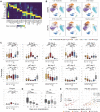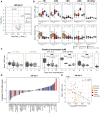Type I interferon autoantibodies are associated with systemic immune alterations in patients with COVID-19
- PMID: 34429372
- PMCID: PMC8601717
- DOI: 10.1126/scitranslmed.abh2624
Type I interferon autoantibodies are associated with systemic immune alterations in patients with COVID-19
Abstract
Neutralizing autoantibodies against type I interferons (IFNs) have been found in some patients with critical coronavirus disease 2019 (COVID-19), the disease caused by severe acute respiratory syndrome coronavirus 2 (SARS-CoV-2). However, the prevalence of these antibodies, their longitudinal dynamics across the disease severity scale, and their functional effects on circulating leukocytes remain unknown. Here, in 284 patients with COVID-19, we found type I IFN–specific autoantibodies in peripheral blood samples from 19% of patients with critical disease and 6% of patients with severe disease. We found no type I IFN autoantibodies in individuals with moderate disease. Longitudinal profiling of over 600,000 peripheral blood mononuclear cells using multiplexed single-cell epitope and transcriptome sequencing from 54 patients with COVID-19 and 26 non–COVID-19 controls revealed a lack of type I IFN–stimulated gene (ISG-I) responses in myeloid cells from patients with critical disease. This was especially evident in dendritic cell populations isolated from patients with critical disease producing type I IFN–specific autoantibodies. Moreover, we found elevated expression of the inhibitory receptor leukocyte-associated immunoglobulin-like receptor 1 (LAIR1) on the surface of monocytes isolated from patients with critical disease early in the disease course. LAIR1 expression is inversely correlated with ISG-I expression response in patients with COVID-19 but is not expressed in healthy controls. The deficient ISG-I response observed in patients with critical COVID-19 with and without type I IFN–specific autoantibodies supports a unifying model for disease pathogenesis involving ISG-I suppression through convergent mechanisms.
Figures




References
-
- Wu Z., McGoogan J. M., Characteristics of and important lessons from the coronavirus disease 2019 (COVID-19) outbreak in China. JAMA 323, 1239–1242 (2020). - PubMed
-
- Berlin D. A., Gulick R. M., Martinez F. J., Severe Covid-19. N. Engl. J. Med. 383, 2451–2460 (2020). - PubMed
-
- Beigel J. H., Tomashek K. M., Dodd L. E., Mehta A. K., Zingman B. S., Kalil A. C., Hohmann E., Chu H. Y., Luetkemeyer A., Kline S., Lopez de Castilla D., Finberg R. W., Dierberg K., Tapson V., Hsieh L., Patterson T. F., Paredes R., Sweeney D. A., Short W. R., Touloumi G., Lye D. C., Ohmagari N., Oh M. D., Ruiz-Palacios G. M., Benfield T., Fätkenheuer G., Kortepeter M. G., Atmar R. L., Creech C. B., Lundgren J., Babiker A. G., Pett S., Neaton J. D., Burgess T. H., Bonnett T., Green M., Makowski M., Osinusi A., Nayak S., Lane H. C.; ACTT-1 Study Group Members , Remdesivir for the treatment of Covid-19—Final report. N. Engl. J. Med. 383, 1813–1826 (2020). - PMC - PubMed
Publication types
MeSH terms
Substances
Grants and funding
- IK2 CX001034/CX/CSRD VA/United States
- UM1 HG006504/HG/NHGRI NIH HHS/United States
- UL1 TR001863/TR/NCATS NIH HHS/United States
- R35 HL140026/HL/NHLBI NIH HHS/United States
- T32 EB009383/EB/NIBIB NIH HHS/United States
- K24 HL137013/HL/NHLBI NIH HHS/United States
- R35 GM134922/GM/NIGMS NIH HHS/United States
- P30 AR070155/AR/NIAMS NIH HHS/United States
- R01 AI136972/AI/NIAID NIH HHS/United States
- R01 AR071522/AR/NIAMS NIH HHS/United States
- R01 AI088364/AI/NIAID NIH HHS/United States
- R01 HL151552/HL/NHLBI NIH HHS/United States
- U24 HG008956/HG/NHGRI NIH HHS/United States
- U01 HG012192/HG/NHGRI NIH HHS/United States
- 5P01 AI118688-04/NH/NIH HHS/United States
- U19 AI1077439/NH/NIH HHS/United States
- K24 AI144048/AI/NIAID NIH HHS/United States
- T32 GM067547/GM/NIGMS NIH HHS/United States
- HL151552/NH/NIH HHS/United States
- R01 CA094143/CA/NCI NIH HHS/United States
- HHMI/Howard Hughes Medical Institute/United States
- UL1 TR001866/TR/NCATS NIH HHS/United States
- 1F30 DK123915-01/NH/NIH HHS/United States
- U19 AI077439/AI/NIAID NIH HHS/United States
- K23 HL138461/HL/NHLBI NIH HHS/United States
- F30 DK123915/DK/NIDDK NIH HHS/United States
- P01 AI118688/AI/NIAID NIH HHS/United States
- R01 AI163029/AI/NIAID NIH HHS/United States
LinkOut - more resources
Full Text Sources
Other Literature Sources
Medical
Molecular Biology Databases
Miscellaneous

